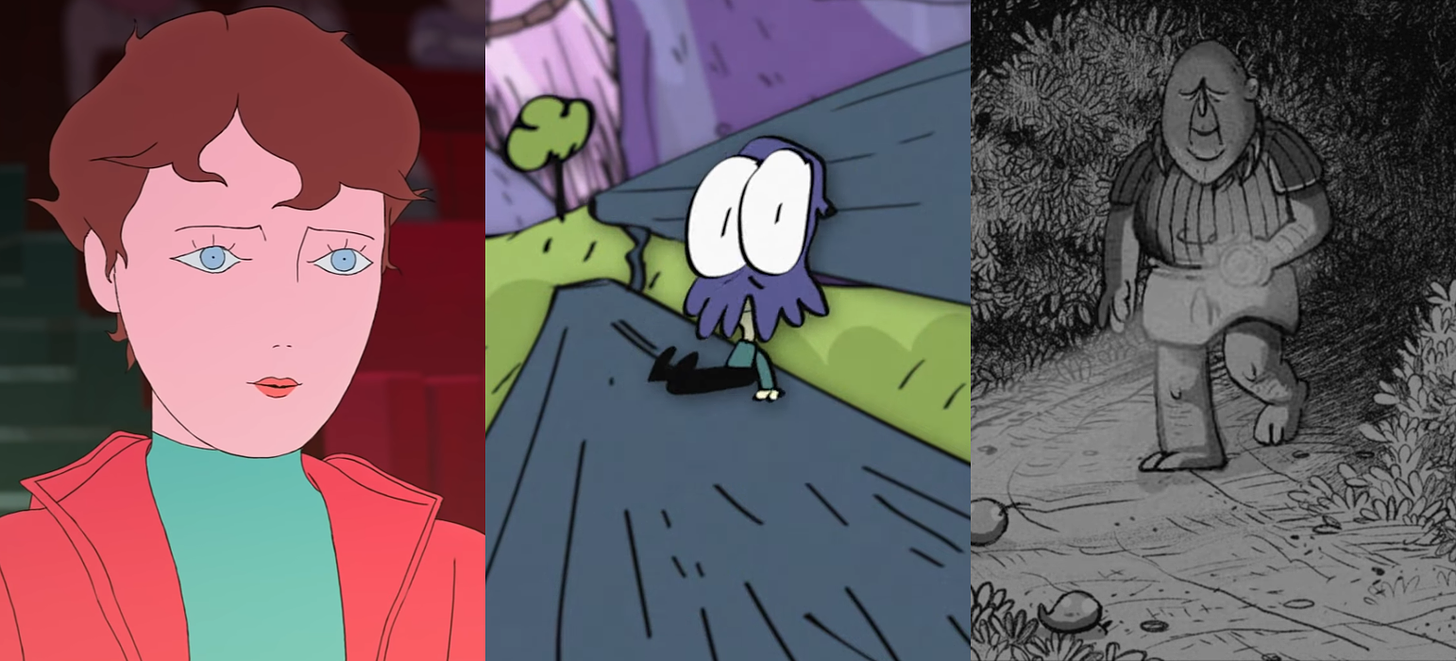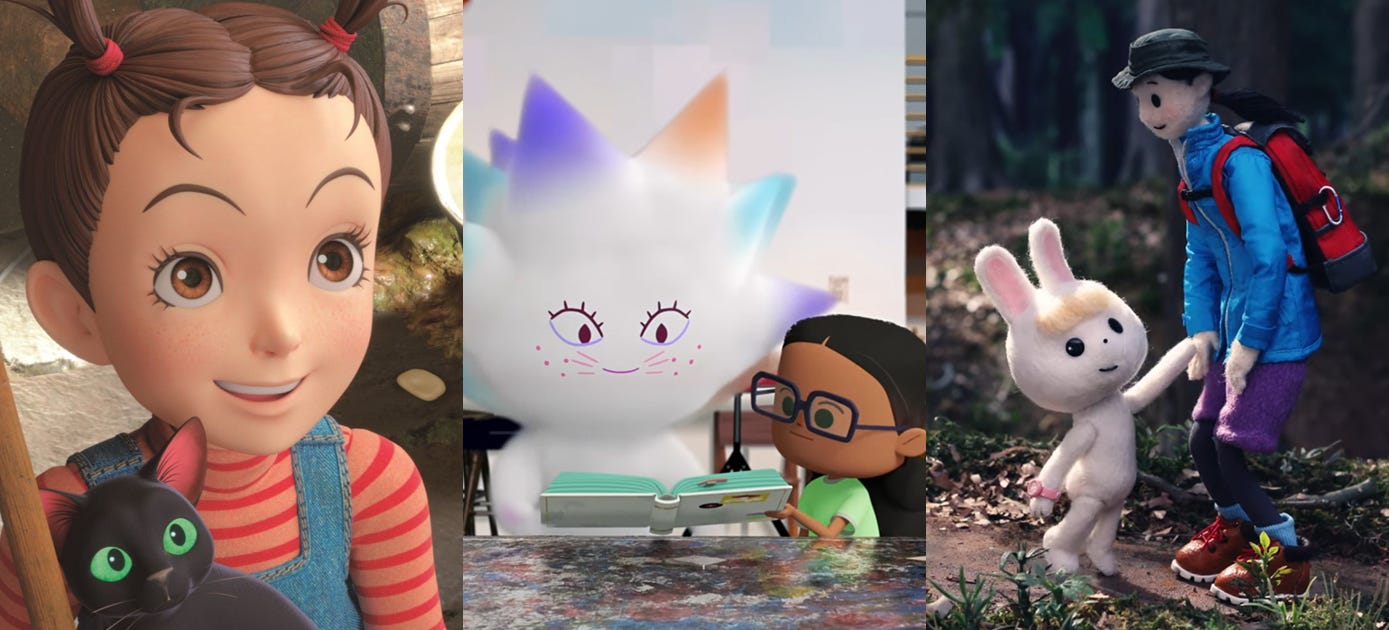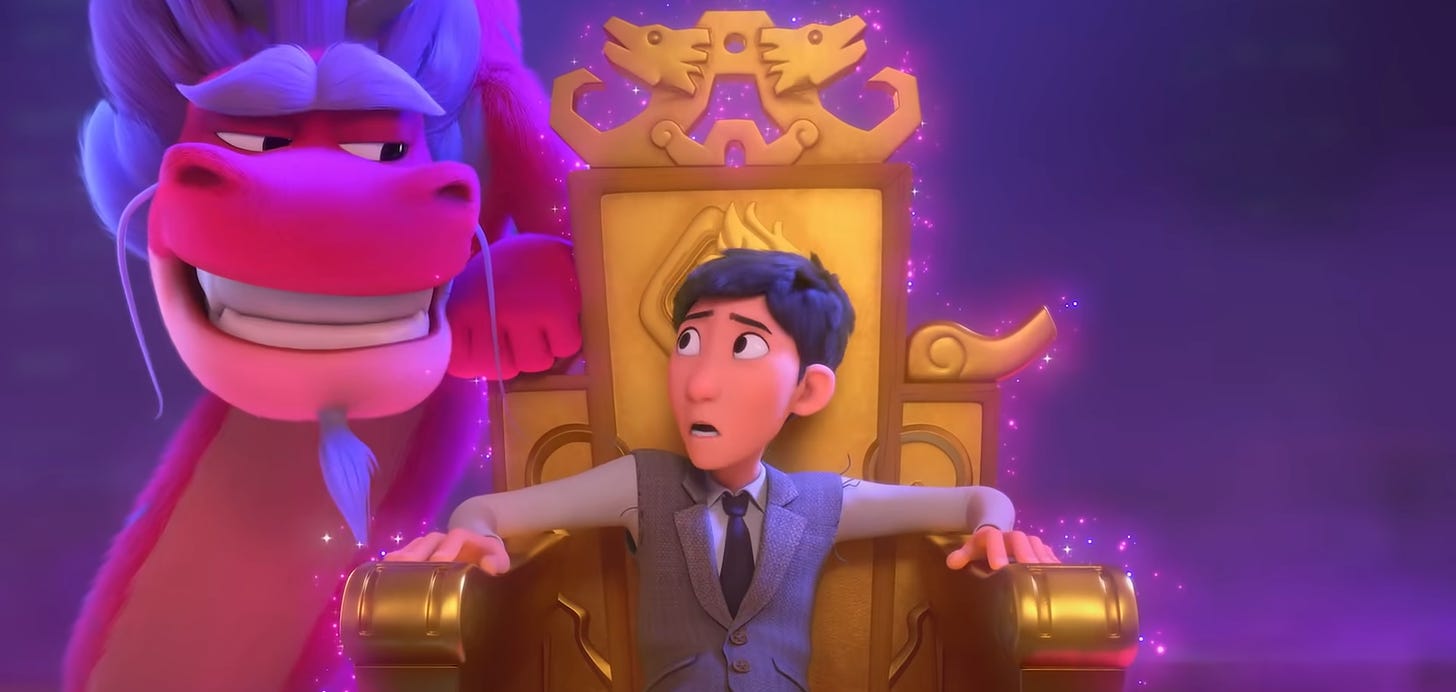What's the Most Underrated Animation of the Year?
Plus: global animation news and Hayao Miyazaki on 'Fantastic Planet.'
Happy New Year! It’s 2022, and we’re back with another edition of the Animation Obsessive newsletter. Thanks for joining us. This is what we’re doing today:
One — picking the year’s hidden gems in animation.
Two — animation news items, worldwide.
Three — what Hayao Miyazaki thought of Fantastic Planet.
Four — the last word.
We publish new issues every Sunday and Thursday. You can sign up to receive our Sunday editions for free, right in your inbox. It only takes a second:
We won’t delay any longer — here we go!
1. Animation that needs love
Over the past 12 months, the world released more animation than any one person could keep track of. (We tried — even working together, it was nearly impossible.) That abundance gave hyped films and series a big advantage: it was hard to find anything else.
So, we’ve opted not to list all of our picks for 2021’s best animation. We really enjoyed projects like Wish Dragon, Mobile Suit Gundam: Hathaway and Maya and the Three — but you already know they’re great. They’ve dominated the conversation. Instead, we’re focusing on our favorite animation of 2021 that hasn’t gotten the acclaim it deserves yet.
Our list below is only the first part of this project. We haven’t caught all of the year’s hidden gems (they’re usually hidden, after all). That’s why we’re inviting you to tell us your own picks.
If you feel that a piece of animation didn’t get enough eyes or praise in 2021, no matter what it is, we want to know. We’ll round up your favorites next Sunday, January 9.
Until then, these are our initial picks for the most underrated animation of 2021.
Stuff to watch now
The first piece we’d like to highlight is one we’ve discussed a lot lately — both in the newsletter and behind the scenes. That’s Barber Westchester by animator Jonni Phillips.
Barber’s placement here isn’t a consolation prize. Even compared to the heavy hitters of 2021, this no-fi film holds up as one of the year’s most creative and exciting works of animation. A 90-minute comedy-horror-drama, it’s a project that Phillips animated largely solo in her free and expressive style. It’s about growing up, cults, parrots eating clay, mental illness, friendship and, above all, hope.
If that sounds overwhelming, it doesn’t feel that way. We’ve watched Barber twice, and the thing we talked about after finishing the second watch was watching it a third time. It’s exclusive to Phillips’ Patreon page right now — access costs as little as $2.
Another film that tackled mental illness in 2021, albeit with a wildly different sensibility, was Contretemps. Free on YouTube, this is a graduation project directed by five students at Gobelins in France.
Contretemps is a beautifully stylized short about a woman with OCD — and her battle against anxiety, symbolized by the demonic creatures that hound her. The film is steeped in the influence of Satoshi Kon’s imagination, and the animation is as slick and crisp as the design. Its portrayal of OCD is smart and sensitive, too.
Demonic creatures also abound in Seen It! from Kerala, India — only these aren’t metaphorical. Seen It! visualizes the stories of PNK Panicker, a real-world man in his 90s who spins tall, dead-serious tales about meeting monsters from the local folklore.
The director is Adithi Krishnadas, a young artist with a background at Vaibhav Studios — our favorite animation team in India. She made Seen It! for a different company, but the Vaibhav style is still all over this piece, which makes it a fun and lively watch. It also strongly brings to mind the work of Shigeru Mizuki (a good thing).
City of Ghosts takes on a spectral theme of its own. And, in the California industry, it’s the poster child for 2021’s overlooked gems.
The series is part mixed-media art project, part experimental mumblecore film, part animated documentary about Los Angeles. Although City of Ghosts is relaxed, and funny in a lighthearted way, it tackles complex and sometimes heavy topics. There’s even a poem about colonialism, spoken partly in Tongva.
In one sense, it’s not shocking that City of Ghosts has gone unseen. It’s a show for kids, but it skews older with its dialogue and avant-garde style. Watching it, we could only think of something that a critic once wrote about UPA’s Gay Purr-ee — it’s for the “four-year-old of recherché taste.” But that weird mix is also what makes it interesting. We recommend it for both four-year-olds of recherché taste and the young at heart.
If City of Ghosts is the bomb that everyone wanted to succeed, then Earwig and the Witch is the bomb that everyone wanted to fail. From the minute Studio Ghibli revealed this latest film from Gorō Miyazaki, the hatred was palpable. Coupled with the pandemic, it’s unsurprising that Earwig hasn’t done much.
But is it really that bad? After it popped up in America last year, we watched Earwig and found it charming and above all different. It’s certainly odd, from its visual look to its ultra-slow pace, but it’s also blissfully free of stereotypes and clichés. The storytelling is unique, and the animation and design come off as Ghibli’s own, homebrew style of CGI — dodging the trap of looking generic.
Hayao Miyazaki himself has praised Gorō’s film and its use of 3D. “By not drawing with a pencil and doing things in CG instead, he’s been released,” he said. It’s not a masterpiece, and you don’t have to love it, but Earwig deserves a fair shot.
Last in this section is Warm Hands. There isn’t much to say about it that isn’t better said by the piece itself. Four minutes long, and free, it’s a stop-motion short by the Japanese studio Dwarf (Rilakkuma and Kaoru). It was made to support cancer patients and hospital staff amid the COVID-19 pandemic.
Warm Hands has only 11,000 views on YouTube, but it’s one of the most moving and uplifting pieces of animation we’ve seen in 2021. You might cry.
Stuff to look for

Some of the hidden gems we saw last year are hidden because they’ve only played at festivals. A few have even won top awards at those festivals. We’re calling these six underrated because the world needs to see them. When they become available, we recommend checking them out.
First, there’s The Bones from Chile. Cristóbal León and Joaquin Cociña seem destined to make the most disturbing, forbidden-feeling animation of the year whenever they release a new film. (If you haven’t watched their Wolf House, it’s free on Tubi and unlike anything you’ve seen.) The Bones claims to be the first stop-motion film ever made. The atmosphere it conjures is oppressive, evil and unforgettable.
Next, we have two of our favorite films of 2021 — Fall of the Ibis King (Ireland) and The Shaman’s Apprentice (Canada).
We’ve written about them before. In November, we called Ibis King “raw intensity from the first second” and “almost unbelievably cool.” It’s possibly the best student film of the year. As for The Shaman’s Apprentice, it’s a stop-motion masterwork by Zacharias Kunuk, an Inuk director from the live-action world. We wrote in June:
The film employs the long, immersive shots usually saved for live-action, and they work. That’s because the puppet animation has a weightily natural feel, and because of the lighting. The way this film is lit defies belief. It’s so seamless, so evocative, that you can’t imagine it was shot one frame at a time.
None of this applies to Vadim on a Walk. Sasha Svirsky in Russia delivers a piece that’s purposely messy and broken — he even draws on meme aesthetics like glitched sound, burnt-out colors and bad 3D animation.
Yet what he’s made is both funny and uncomfortably real. Vadim is a story about cycles of power — a man’s desire to be free, the way he relishes his freedom and how that very freedom leads him back into a small glass box. It’s about the people who enable state violence, and it speaks to Russia’s own cycle of tyranny, from the Tsarists to the Soviets to today. Svirsky handles it all without an ounce of pretension.
We’ll end with Fledge from Israel and A Bite of Bone from Japan. The first is stop-motion, and the second is a kind of animation we’ve never seen before: pointillism.
We had the honor of presenting Fledge with an award at Calgary’s GIRAF festival in November. “Fledge uses its refreshingly specific and unique premise — a Russian family trying to fit into Israel during the 1990s — to tell a story about heritage, identity and individuality that resonates at the universal level,” we wrote. We stand by that description.
A Bite of Bone, produced by Kōji Yamamura and directed by the young animator Honami Yano, isn’t as easy to sum up. Yano tells a story from her childhood, about her father, that’s full of mystery. Her animation warps and bends, as the colorful dots she drew with physical markers dance in every direction. If you can see it, it’s a one-of-a-kind experience.
2. News around the world
The trends and lessons of 2021
In animation, the theme of 2021 was more. As the COVID-19 pandemic raged for its second year, and the demand for streaming exploded, animators continued to steal slots from a live-action industry that’s struggling to film anything.
This was the case in America, but also everywhere else. Rounding up 2021 in Indian animation, the head of Toonz Media Group told AnimationXpress:
Overall, I think like the rest of the industry, we benefited from the increasing demand for content in the last two years; especially the skyrocketing demand for kids’ content. The pandemic has essentially compelled all of us to think global in every aspect.
Even places you wouldn’t normally associate with animation are getting into it — spurred by investors and governments eager to join this fast-growing industry. Russia spent much of the year developing animation in its Far Eastern Federal District.
At the same time, this production boom hasn’t led to a boom in wages for animators. As we’ve reported for months, animators from America to Japan and beyond are overworked, underpaid and lacking in any real form of job security. In many countries, production is less of an art and more of a conveyor belt.
That’s despite the money animation is making. In Japan, the year’s three highest-grossing films are animated — Evangelion 3.0+1.0 took first place. Even in Indonesia, the top homegrown film of the year, Nussa, is animated. The trend holds globally: Wish Dragon was the year’s fourth-most-streamed film on Netflix.
Going into 2022, it’s clear that conditions need to improve. In America, The Animation Guild is working on it now. Unless something is done soon, things will only get worse — as streaming rises, television is dying, which pushes more and more artists into the unfair terms that streaming services tend to offer.
Best of the rest
This week brought news of two passings in animation — clay animator Barry Bruce and character designer Derrick Wyatt (Teen Titans, Ben 10). On Twitter, Jorge Gutierrez wrote about how Wyatt mentored him early in his career.
In China, the animation anthology To the Bright Side is coming January 15 — seven shorts in different styles, on the theme of childhood. See a trailer here.
The hyped film I Am What I Am has done acceptably at the Chinese box office. It’s the fifth homegrown animated feature to break 100 million yuan (a little under $16 million) in 2021, according to Mtime.
Jujutsu Kaisen 0 is a big hit. During its three-day opening weekend in Japanese theaters, it saw returns topped only by Demon Slayer the Movie.
Anime News Network has rounded up an animation director’s horrifying and gripping account of production gone wrong in Japan. “I’m aboard a sinking ship!” he writes. “We’re about to go under! Hahaha!”
Cartoon Brew has an awesome behind-the-scenes feature on the Mexican stop-motion series Frankelda’s Book of Spooks.
As part of the ongoing rights dispute between companies in Japan and Russia, the Japanese Cheburashka site and social media accounts have closed.
At the Annies this month, Japanese producer Toshio Suzuki (Studio Ghibli) will be presented with the Winsor McCay Award for lifetime achievement.
Lastly, we were on break when it happened, but the Oscar shortlist for animated shorts dropped. Some of our recent favorites, like BoxBallet (2020) and The Shaman’s Apprentice, are among them. Here’s hoping they make the cut.
3. Miyazaki on Fantastic Planet
Hayao Miyazaki has watched and read more widely than most people. He’s also hypersensitive. “Those close to him know that he feels things in an unusually powerful way,” wrote his late friend Isao Takahata.1 As a result, Miyazaki has lots of opinions about art — and his takes are fascinating even when you disagree with them.
With this in mind, we’re starting a new occasional series about Miyazaki’s comments on animation he’s seen. The first is Fantastic Planet — a film that needs no introduction.
Miyazaki first caught Fantastic Planet at a special screening around 1980. It came at a pivotal time. Feeling that his career had hit a dead end, he once called 1980 his “year of being mired in gloom.” It nearly marked the end of his animation career.
“With every piece I made it was obvious that I was just trotting out everything I had done before,” he said. Seeing Fantastic Planet intensified these feelings. When Miyazaki published a piece about it in early 1981, he wrote, “I’ve had so much pent-up frustration since seeing the film that it’s been hard for me to put pen to paper.”
Fantastic Planet did impress him. “On a technical level it was amazing,” he remarked. Yet it ultimately left him cold. After thinking about it, he came to believe that the film and his own work both suffered from an “absence of art.” Miyazaki used the word bijutsu, which can also translate as “fine art.”2
As a filmmaker and a viewer, Miyazaki has always favored popular entertainment. But, here, he was torn. “I don’t dislike popular literature or films created for the masses, but I have this feeling that we’ve just been producing works according to an established formula,” he wrote. Miyazaki felt that the “absence of bijutsu” in Fantastic Planet, as in his own work, confined it to “second-class status.”
In his comments about Fantastic Planet, he didn’t come away with any real answers. He was moved to do something, though. Near the end of the piece, he wrote:
Either way, concerning the absence of art […] there’s probably nothing left for me to do except to start sliding into a mood of desolation, tortured by my own conscience. It has really made me think about how I have to work to somehow open holes in the walls that surround us.
That thinking led somewhere. Miyazaki soon embarked on the most ambitious work of his career — the manga series Nausicaä of the Valley of the Wind. And, as the Japanese writer Seiji Kanō has noted, it has a few things in common with Fantastic Planet.
4. Last word
That’s the end of our first issue of 2022! Thanks for reading.
Our next issue drops on Thursday, exclusively for members. Membership costs $10 per month or $100 per year. Students can click here for a 40% discount.
One last thing. If you missed it, we recently published an issue about Studio Ghibli’s super-fun music video series Judy Jedy. It’s way outside what most people expect from Ghibli. In our piece, we study the videos and explore behind the scenes — looking at how and why their director and the Japanese band Capsule put this project together. We hope you’ll check it out.
See you again soon!
From Starting Point 1979–1996, also our source for Miyazaki’s words throughout the Fantastic Planet section.
Miyazaki’s comments rely on the Japanese distinction between bijutsu, which can literally translate to “beautiful artifice,” and gijutsu (skill, technology). He wrote that the gijutsu of Fantastic Planet impressed him, but that the film, like his own work, lacked higher aesthetic value.







